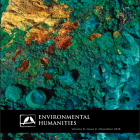Granjou, Céline and Juan Francisco Salazar. “Future.” Environmental Humanities 8, no. 2 (2016): 240-244. doi:10.1215/22011919-3664342.
Alfred North Whitehead once insinuated that the present is perceived as “the vivid fringe of memory tinged with anticipation.” But imagining the future as some kind of extension of the past can also be flawed. As we are confronted today with unprecedented futures of exponentially rising temperatures and brutal ecological tipping points, it might indeed be the right time for the social sciences and humanities to appreciate—and act on the fact—that humans do not build “their” futures alone. While much needed attention has been given to the entanglements of humans and environments that are creating new connections and proximities in a global world, now is the time to address the shared futurities of nature-culture entanglements. This is not only because impending radical environmental changes orient human and nonhuman beings toward shared possibilities; this is also because nonhumans (animals, plants, things, matter, and ecological and physical forces) themselves instigate change and trigger the advent of futures often perceived as uncertain and predictable. “Our” future is unquestionably a more than human future. (Adapted from authors’ text)
© Céline Granjou and Juan Francisco Salazar 2016. Environmental Humanities is available online only and is published under a Creative Commons license (CC BY-NC-ND 3.0).


